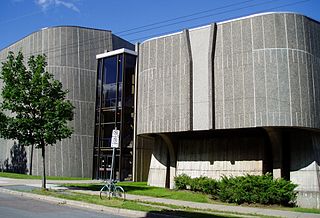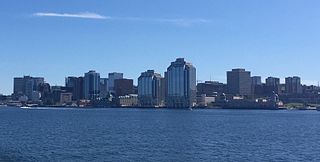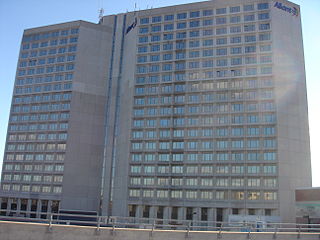
Dalhousie University is a large public research university in Nova Scotia, Canada, with three campuses in Halifax, a fourth in Bible Hill, and a second medical school campus in Saint John, New Brunswick. Dalhousie offers more than 4,000 courses, and over 200 degree programs in 13 undergraduate, graduate, and professional faculties. The university is a member of the U15, a group of research-intensive universities in Canada.

An eco-industrial park (EIP) is an industrial park in which businesses cooperate with each other and with the local community in an attempt to reduce waste and pollution, efficiently share resources, and help achieve sustainable development, with the intention of increasing economic gains and improving environmental quality. An EIP may also be planned, designed, and built in such a way that it makes it easier for businesses to co-operate, and that results in a more financially sound, environmentally friendly project for the developer.

The Halifax Forum is an arena and multi-purpose facility in Halifax, Nova Scotia. Its uses include sporting events, bingo, ice skating, concerts and markets. It was built in 1927 on the site of the former Nova Scotia Provincial Exhibition which was badly damaged by the Halifax explosion in 1917. It opened on 26 December 1927 and incorporated the first artificial ice surface east of Montreal. It is the second biggest arena in Nova Scotia, and the fifth biggest in Atlantic Canada. The building was added to the Canadian Register of Historic Places in 2003.

The Spring Garden Road area, along with Barrington Street is a major commercial and cultural district in Halifax, Nova Scotia, Canada. It acquired its name from the fresh water spring that flows directly beneath it. It comprises Spring Garden Road, South Park Street, and a number of smaller side streets. The area is considered to be one of the trendiest areas in Halifax and is the busiest shopping district east of Quebec.

The Dalhousie Arts Centre, at Dalhousie University in Halifax, Nova Scotia, contains a number of theatres, Dalhousie Art Gallery, classrooms, and a sculpture garden. It remains the premier performing arts venue in Halifax. It was opened officially in November, 1971, and is also home to Dalhousie's Fountain School of Performing Arts.

Downtown Halifax is the primary central business district of the Municipality of Halifax. Located on the central-eastern portion of the Halifax Peninsula, on Halifax Harbour. Along with Downtown Dartmouth, and other de facto central business districts within the Municipality, Downtown Halifax serves as the business, entertainment, and tourism hub of the region.

Scotia Square is a commercial development in downtown Halifax, Nova Scotia, Canada. It was built from the late 1960s to late 1970s and is managed by Crombie REIT.

The Maritime Centre, in Downtown Halifax, Nova Scotia, Canada, is an office building, home to the regional telecommunications company Bell Aliant. The main entrance to the building sits on the prominent corner of Barrington Street and Spring Garden Road.

Hosting the region's largest urban population, Halifax, Nova Scotia is an important cultural centre in Atlantic Canada. Halifax is home to a vibrant arts and culture community that enjoys considerable support and participation from the general population. As the largest community and the administrative centre of the Atlantic region since its founding in 1749, Halifax has long-standing tradition of being a cultural generator. While provincial arts and culture policies have tended to distribute investment and support of the arts throughout the province, sometimes to the detriment of more populous Halifax, cultural production in the region is increasingly being recognized for its economic benefits, as well as its purely cultural aspects.

The IWK Health Centre is a major pediatric hospital and trauma centre in Halifax, Nova Scotia that provides care to maritime youth, children and women from Nova Scotia, New Brunswick, Prince Edward Island and beyond. The IWK is the largest facility in Atlantic Canada caring for children, youth and adolescents, and is the only Level 1 pediatric trauma centre east of Quebec.
Saint Mary's University (SMU) is a formerly Catholic, public university located in Halifax, Nova Scotia, Canada. The school is best known for having nationally leading programs in business and chemistry. The campus is situated in Halifax's South End and covers approximately 32 hectares.

Barrington Street is a major street in Halifax, Nova Scotia, Canada, running from the MacKay Bridge in the North End approximately 7 km south, through Downtown Halifax to Inglis Street in the South End. Its civic numbers range from 950 to 4756 on the Halifax Peninsula street grid numbering system.

Robie Street is a north-south artery that runs for 7 km in the Halifax Peninsula area of the Halifax Regional Municipality, from Memorial Drive in the North End Halifax, to Gorsebrook Avenue in the South End.

Queen Elizabeth II Health Sciences Centre, in Halifax, Nova Scotia, Canada, is a large teaching hospital and Level 1 Trauma Centre affiliated with Dalhousie University. The QEII cares for adult patients. Pediatric patients within the region are cared for at the IWK Health Centre. Administratively, the QEII is part of the Nova Scotia Health Authority.
The Capital District Health Authority was the largest of the nine health authorities in the Canadian province of Nova Scotia. In 2015 it was merged into the new, province-wide Nova Scotia Health Authority.

Andrew Younger is a Canadian politician and journalist, first elected to the Nova Scotia House of Assembly in the 2009. He represented the district of Dartmouth East first as a member of the Nova Scotia Liberal Party and subsequently as an Independent. In 2015, Younger was removed from cabinet and the Liberal caucus after invoking parliamentary privilege in order to avoid giving testimony at a criminal trial.

Burnley Allan "Rocky" Jones was an African-Nova Scotian and an internationally known political activist in the areas of human rights, race and poverty. He came to prominence first as a member of the Student Union for Peace Action (SUPA) during the 1960s and then as a civil rights activist, community organizer, educator, and lawyer.

The Point Aconi Generating Station is a 165 MW Canadian electrical generating station located in the community of Point Aconi, Nova Scotia, a rural community in the Cape Breton Regional Municipality. A thermal generating station, the Point Aconi Generating Station is owned and operated by Nova Scotia Power Corporation. It opened on August 13, 1994 following four years of construction.

William Pearly Oliver worked at the Cornwallis Street Baptist Church for twenty-five years (1937–1962) and was instrumental in developing the four leading organizations to support Black Nova Scotians in the 20th century: Nova Scotia Association for the Advancement of Colored People (1945), the Nova Scotia Human Rights Commission (1967), the Black United Front (1969) and the Black Cultural Centre for Nova Scotia (1983). He was instrumental in supporting the case of Viola Desmond. Oliver was awarded the Order of Canada in 1984.
Halifax Tool Library (HTL) is a tool lending library based in Halifax, Nova Scotia, Canada. Members pay an annual subscription and may borrow specialized tools for home repair, maintenance, building projects, community projects, gardening and landscaping. The HTL is a registered Non Profit community organization in Nova Scotia. The HTL offers standard, Student/Low-Income option, and organizational memberships to non-profits and small businesses. The HTL is supported by the HRM Capital Grant program, Dalhousie University student union, the Veith House Society, Ecology Action Centre, Parker Street food & furniture bank, Forest Friend, Bike Again, North Brewing Company, Catalyst, Fusion HFX, Deiter's tool and Saw.
















